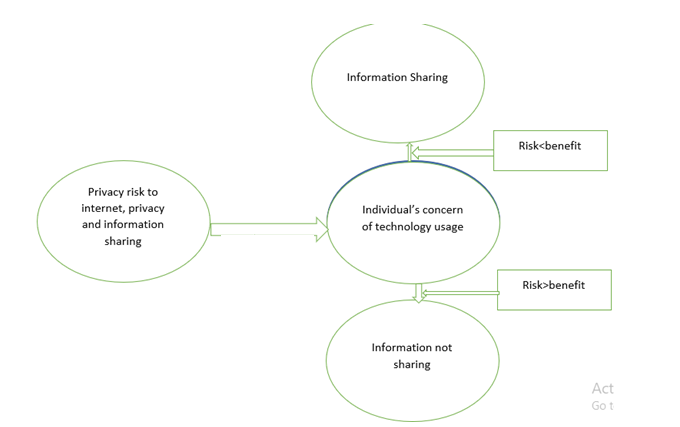Difference between revisions of "Privacy Calculus Theory"
(PCT) |
(PCT_final) |
||
| (One intermediate revision by the same user not shown) | |||
| Line 30: | Line 30: | ||
== External Links: == | == External Links: == | ||
| − | * https://essay.utwente.nl/75407/1/Kruthoff_BA_BMS.pdf | + | * https://essay.utwente.nl/75407/1/Kruthoff_BA_BMS.pdf One of the use cases of Privacy Calculus Theory |
| − | * https://www.efmaefm.org/0EFMAMEETINGS/EFMA%20ANNUAL%20MEETINGS/2017-Athens/papers/EFMA2017_0512_fullpaper.pdf | + | * https://www.efmaefm.org/0EFMAMEETINGS/EFMA%20ANNUAL%20MEETINGS/2017-Athens/papers/EFMA2017_0512_fullpaper.pdf One of the perspectives of Privacy Calculus Theory |
| − | * https://adlnet.gov/assets/uploads/2017%20---%20(SSRN%20Journal)%20Knijnenburg%20et%20al.%20-%20Death%20To%20The%20Privacy%20Calculus.pdf | + | * https://adlnet.gov/assets/uploads/2017%20---%20(SSRN%20Journal)%20Knijnenburg%20et%20al.%20-%20Death%20To%20The%20Privacy%20Calculus.pdf Challenge to the rationale of Privacy Calculus Theory |
| + | |||
| + | == Originating Area: == | ||
| + | E-commerce setting, Online social networks | ||
| + | |||
| + | == Level of Analysis: == | ||
| + | Individualistic | ||
| + | |||
| + | == Originating Contributors: == | ||
| + | Bibaswan Basu | ||
| + | * | ||
* | * | ||
Latest revision as of 11:29, 23 September 2021
Main dependent construct/Factor(s):
Individuals’ attitude or intention or behaviour towards privacy concern or E-commerce usage
Main independent construct/Factor(s):
Perceived risk related to internet, privacy, information sharing
Concise Description of the theory:
Many customer-oriented data are created with the introduction of information technology. It has been showed that privacy concerns increased considerably since 2001, based on 3 million client data for the period 2001-2008, less individuals are ready to give their data, with older persons having a lower probability of sharing their data. A cost-benefit evaluation frequently involves the disclosure of personal data. Although people typically profit from both financial and non-monetary advantages from online services (e.g., Social Networking Website or E-Commerce apps), businesses frequently analyse this user information for the aim of targeted advertising, product customization or pricing. In 1977 Laufer and Wolfe created the idea of the Privacy Calculus, the view that privacy as an economic commodity may be exchanged in return for other goods or certain advantages.
The Privacy Calculus theory, formerly known as the behaviour calculus, implies that individuals consider future reactions. Economically, this means that the related costs and advantages are weighed. In the privacy context, the cost is frequently associated with specific dangers that might arise from the exposure of information. Thus, individuals are involved in an autonomous risk-benefit analysis or deal-off when they are faced with the communication of personal information. Some people characterise perceived privacy risks as the recipient's possible opportunistic behaviour that might take place when a person reveals his/her personal details resulting to a possible loss of control. This can take the shape of secondary use (e.g., the sale or sharing with third parties of personal information), illegal access, theft, etc. The Privacy Calculus idea is commonly utilised or combined with other theories to describe the trade-off between risk and reward. Therefore, it is found, that the Privacy Calculus theory is often associated with the “Utility Maximization theory”, “Expectancy theory of motivation”, and “Expectancy-value theory”.
Originating authors:
Laufer and Wolfe (1977)
Diagrammatic representation:
Seminal article:
- Laufer, R.S. and Wolfe, M. (1977), Privacy as a Concept and a Social Issue: A Multidimensional Developmental Theory. Journal of Social Issues, 33: 22-42. https://doi.org/10.1111/j.1540-4560.1977.tb01880.x
- Ba, S. (2001). Establishing online trust through a community responsibility system. Decision Support Systems, 31(3), 323–336. https://doi.org/10.1016/S0167-9236(00)00144-5
- Blatchford, C. (2000). Information security, business and the internet — Part 1. Network Security, 2000(1), 8–12. https://doi.org/10.1016/S1353-4858(00)86650-7
IS articles that use the theory:
- Jozani, M., Ayaburi, E., Ko, M., & Choo, K. K. R. (2020). Privacy concerns and benefits of engagement with social media-enabled apps: A privacy calculus perspective. Computers in Human Behavior, 107, 106260. https://doi.org/10.1016/J.CHB.2020.106260
- Ma, X., Qin, Y., Chen, Z., & Cho, H. (2021). Perceived ephemerality, privacy calculus, and the privacy settings of an ephemeral social media site. Computers in Human Behavior, 124, 106928. https://doi.org/10.1016/J.CHB.2021.106928
- Trepte, S., Scharkow, M., & Dienlin, T. (2020). The privacy calculus contextualized: The influence of affordances. Computers in Human Behavior, 104, 106115. https://doi.org/10.1016/J.CHB.2019.08.022
External Links:
- https://essay.utwente.nl/75407/1/Kruthoff_BA_BMS.pdf One of the use cases of Privacy Calculus Theory
- https://www.efmaefm.org/0EFMAMEETINGS/EFMA%20ANNUAL%20MEETINGS/2017-Athens/papers/EFMA2017_0512_fullpaper.pdf One of the perspectives of Privacy Calculus Theory
- https://adlnet.gov/assets/uploads/2017%20---%20(SSRN%20Journal)%20Knijnenburg%20et%20al.%20-%20Death%20To%20The%20Privacy%20Calculus.pdf Challenge to the rationale of Privacy Calculus Theory
Originating Area:
E-commerce setting, Online social networks
Level of Analysis:
Individualistic
Originating Contributors:
Bibaswan Basu
